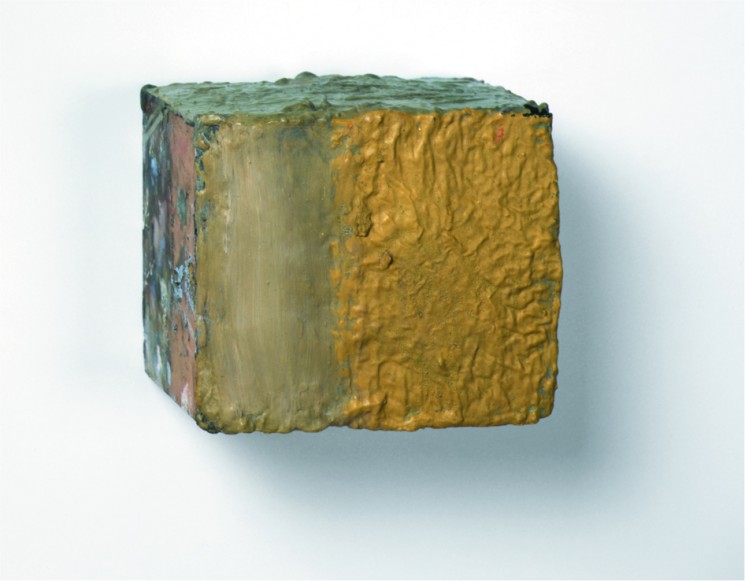Pierre Tal-Coat
Untitled (No. 662)

“In its perfection the object looses its worth as an object and lifts itself up to a spirituality, which complies with our highest expression: the secret is born by a power that constantly is close to explosion“.
Pierre Tal-Coat (1905-1985), despite his fall into oblivion, is considered one of the most significant French painters of Classical Modernism. Tal-Coat, born as Pierre Jacob, started his career in 1932 as an autodidact in Brittany, studying painting, graphic and sculpture within his oeuvre. In 1925 he went to Paris and immersed in the artist’s circles of the Ecole de Paris. It was there that he started to paint still lifes, figural paintings, and landscapes in a realistic manner under the pseudonym Tal-Coat and joined the group ”Forces Nouvelles“. In the series „Massacres“ (1936-37), which discusses the Spanish Civil War, his style gains similarities with Picasso and Matisse. Some of his paintings also present a proximity to Cézanne whose heritage he repeatedly was confronted with due to various stays in Aix-en-Provence.
In 1947 Tal-Coat radically changed his style. André Masson introduced him to Chinese paintings, especially to landscape paintings from the Song period (960-1279). In addition to that he focused in detail on geology and Paleolithic art. In 1960 he turned away from Paris and the artist‘s circles of the capital and settled in Normandy. He often integrated references to the primitive and untouched nature into his works by using archaic symbols or animal traces. He accordingly slipped his observation of natural phenomena into an increasing process of abstraction striving to succeed in his aim to visually come close to the absolute and existential.
Along with the artists of the new School of Paris, the Galerie de France (from 1943 to 1965), the Galerie Maeght (from 1954 to 1974), Benador (from 1970 to 1980), the HM gallery, the Clivage gallery and the Berthet-Aittouarès gallery all regularly exhibited his paintings. In 1956 six of his paintings were shown at the Venice Biennale. In 1963 he collaborated alongside Joan Miró and Ubac in the creation of the Maeght foundation designing the wall mosaic for the entrance. In 1968 he received the Grand Prix National des Arts. A large retrospective exhibition devoted to his work was held at the Grand Palais in Paris in 1976.
The work without title (No. 662) from 1980 dates to the abstract late phase starting at the beginning of the 1980s shortly before Tal-Coat‘s death in 1985. A cigar box serves as an unusual painting ground, a medium he discovered for himself especially in the last years of his work. Tal-Coat already developed the painting style of his main work starting in the 1960s when he did not use the classic method of painting on canvas any more but engaged directly in the layers of paint. He sometimes scratched, scraped and uncovered what had already been covered. Subsurface layers reappear. The result is a ”peinture en matière“ with an intensely structured surface. Tal-Coat deliberately integrated the characteristics of the material – the different layers of paint, paint encrustations and culminations or cracks – into the composition of the painting, sometimes even painting the edges as well. So the process of drawing can be recalled by looking at them, underlining the narrative element of the creative process.
Certain sections captivate by their gloss others in contrast by their subtle dullness. Accordingly, the composition and luminosity of his colours was very important to Tal-Coat. In most cases he grinded his pigments and mixed his colours himself. The painterly gesture as well as the colour turn into the generating power of the pictorial space. Colour and theme melt together and turn into colour matter and shining light source. ”It is the role of the colours which I can‘t separate from the rhythm, this transcendental reality in which the individual develops. It‘s the living that counts”.
In Tal-Coat‘s works one can almost feel the mystic, transcendental analysis of nature and the world itself. He strived to recreate the elements of reality, which constitute the perceived by their equivalents. In a platonic sense he focused on the idea of the pictured element. Tal-Coat does not offer aspects but moments, passages of nature, the ”presence” as he would have called it. Samuel Beckett attested to Tal-Coat: ”Whether achieved by submission or ability, the result is a gaining of nature”.